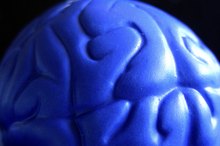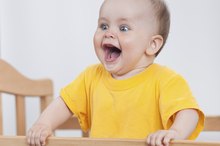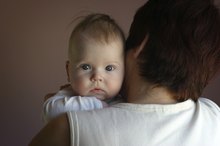Signs of Autism at 1 Year Old
The National Institute of Mental Health notes that that the differences between an infant with autism and an infant without the disorder become apparent between 12 and 36 months of age 2. When autism is caught early, intensive treatment may be able reverse some of the symptoms or lessen the severity of the disorder, explains HelpGuide.org 3. However, since the signs of autism consist of the absence of normal behavior rather than the presence of specific signs, parents can miss some of the early warning signs 3. Parents who learn more about what the average one year old can do may better understand when their baby may be at risk of having this disorder.
No Babbling
Infants with autism often do not begin babbling by 12 months. Between the ages of 12 months to 16 months, most infants say their first word. Infants with autism, on the other hand, may not. Infants that begin babbling or saying single words, but then suddenly stop may also have autism.
- Infants with autism often do not begin babbling by 12 months.
No Gesturing
Signs of Autism in a Three-Year-Old
Learn More
Many infants start to use meaningful gestures by the time their first birthday arrives. These meaningful gestures may include waving or lifting up their arms when they want someone to carry them. They may bring objects to their parents or point to things that interest them. Infants with autism, however, often do not make any of these meaningful social gestures. As with babbling, some one-year-old babies with autism may have made these gestures previously, but suddenly stopped using them.
- Many infants start to use meaningful gestures by the time their first birthday arrives.
- Infants with autism, however, often do not make any of these meaningful social gestures.
Limited or No Social Interaction
From a very early age, most babies enjoy smiles and being cuddled or held. Babies with autism usually do not respond to these things as other babies do. While many one-year-old babies may make noises to get your attention or imitates facial expressions, most one-year-old babies with autism do not. Smiles and eye contact usually do not occur in response to others. They may seem indifferent to expressions of anger or affection. Infants with autism also may not respond to their own name like others their age, and games of peek-a-boo or itsy-bitsy-spider usually do not hold the same appeal. Some infants may have responded to social interaction early on, but the regressed and stopped showing this social awareness.
- From a very early age, most babies enjoy smiles and being cuddled or held.
- While many one-year-old babies may make noises to get your attention or imitates facial expressions, most one-year-old babies with autism do not.
Unusual Play
Signs of Autism in a 9 Month Old
Learn More
One-year-old infants with autism may not play with toys the way their peers do. While other one-year-olds are delighting in dumping containers or making a mess, autistic one-year-olds may spend excessive amounts of time lining up their toys in a particular order. Although many one-year-old children have slight attachment to a certain toy, autistic children may often develop unusual fascinations or obsessions about a certain toy or object.
- One-year-old infants with autism may not play with toys the way their peers do.
- Although many one-year-old children have slight attachment to a certain toy, autistic children may often develop unusual fascinations or obsessions about a certain toy or object.
Related Articles
References
- The Diagnostic and Statistical Manual of Mental Disorders, Fourth Edition"; American Psychiatric Association; 2000
- National Institute of Mental Health: Autism Spectrum Disorder
- HelpGuide: Autism Symptoms and Early Signs
- Medline Plus: Autism
- Centers for Disease Control and Prevention. Screening and diagnosis of autism spectrum disorder. Updated March 13, 2020.
- Lord C, Risi S, DiLavore PS, Shulman C, Thurm A, Pickles A. Autism from 2 to 9 years of age. Arch Gen Psychiatry. 2006;63(6):694-701. doi: 10.1001/archpsyc.63.6.694. PMID: 16754843
- National Institute of Mental Health. Autism spectrum disorder. Updated March 2018.
- Centers for Disease Control and Prevention. Prevalence of autism spectrum disorder among children aged 8 years—autism and developmental disabilities monitoring network, 11 sites, United States, 2016. Published March 27, 2020.
- Cleveland Clinic. Autism. Updated July 20, 2014.
- Centers for Disease Control and Prevention. What is autism spectrum disorder?. Updated March 25, 2020.
- Taylor LE, Swerdfeger AL, Eslick GD. Vaccines are not associated with autism: an evidence-based meta-analysis of case-control and cohort studies. Vaccine. 201417;32(29):3623-9. doi:10.1016/j.vaccine.2014.04.085
Writer Bio
Elizabeth Wolfenden has been a professional freelance writer since 2005 with articles published on a variety of blogs and websites. She specializes in the areas of nutrition, health, psychology, mental health and education. Wolfenden holds a bachelor's degree in elementary education and a master's degree in counseling from Oakland University.








